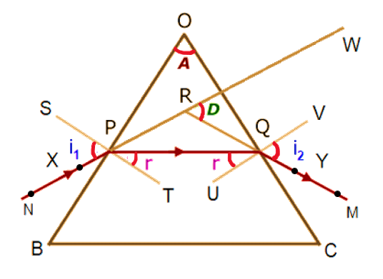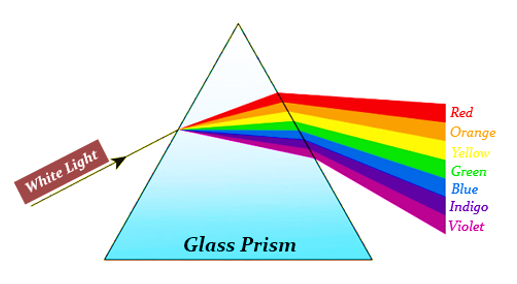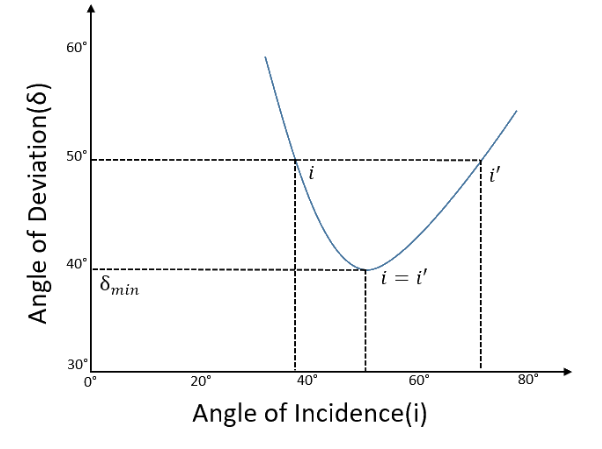Introduction
Have you ever questioned why straw that has been dipped in water appears warped? When the water is added to the glass, the straw appears to bend, but when you remove it, you can see that it hasn’t actually bent at all. Refraction is to blame for this; rather than the straw itself, it bends the light around it. Likewise occurs when a pencil is inserted into a glass of only partially full water. If you look at the pencil, you can see that it looks normal above the water but twisted and a little bigger below. There are numerous such instances of refraction in daily life that will be covered in this chapter.
Refractive index of light
The refractive index of any material is given as the ratio of the speed of light in the vacuum divided (c) by the speed of light in a medium (v), and is presented with a symbol, n, such that,
$$
n=\frac{c}{v}
$$
We can infer from this relationship that optical density and light speed both affect the refractive index. With an increase in optical density, the refractive index often rises. Light may bend more when it enters a denser material than when it enters a rarer one. Additionally, as the medium’s medium’s light speed decreases, the refractive index rises.
Prism
A transparent substance that can reflect light and has at least two lateral surfaces that are obliquely inclined to one another is referred to as a prism. It contains five surfaces, including three rectangle lateral surfaces and two triangle bases. The angle of the prism refers to the angle created by two lateral surfaces. For a standard prism, the prism’s angle is always 60°.
Refraction of light through a prism
A light ray NP is seen entering glass at the initial surface OB in the diagram as it travels from air. Because glass is denser than air, incoming light is bent toward the normal after refraction. When light enters from glass into air at the second surface BC, it bends away from the usual. A line drawn perpendicular to the surface at the incident ray entry point is called a normal. In contrast to angle of emergence, which is the angle produced between the emergent ray and the normal, angle of incidence is the angle formed between the incident ray and the normal. The angle that the emergent ray (stretched rearward) creates with the incident light is known as the angle of deviation ($\angle D$) (extended forward). The equation can be written from angle of prism (∠A), angle of incidence (∠i) and angle of emergence (∠e). Therefore, the expression is given as,
$$
\angle D=\angle i+\angle e-\angle A
$$

Refractive index of a prism
Refractive index of a prism made up of glass is given by the formula,
$$
n=\frac{\sin \frac{(A+D)}{2}}{\sin \left(\frac{A}{2}\right)}
$$
Where n is the refractive index of the prism, A is the angle of the prism and D is the deviation. The deviation is minimum at one point and is called minimum deviation. Using this formula, we can easily calculate the refractive index of the prism.
Angle of deviation
It refers to the angle at which the emergent ray and incident ray make contact. Angle of deviation is affected by a variety of factors.
Refractive index
The refractive index is directly proportional to the angle of deviation.
Angle of prism
The magnitude of the angle of deviation increases with an increase in the angle of the prism.
Wavelength of light
As the wavelength increases, the angle of deviation decreases. Therefore, violet deviates the most, because it has a shorter wavelength.
Temperature
As temperature increases, intermolecular space also increases, density decreases, refractive index decreases and angle of deviation decreases.
Dispersion of light through prism
The white light, composed of the whole spectrum) is divided further into its components called the spectrum when it passes through a prism. This phenomenon is called The white light divides into its seven individual colours. These hues are a part of VIBGYOR (V-violet, I- indigo, B-blue, G-green, Y-yellow, O-orange, R-red). The wavelengths of these hues determine their deviation. Red has the longest wavelength among these colours, whereas violet has the shortest. As we previously established, the angle of departure increases with decreasing wavelength. Due to the fact that light propagates at different speeds, it “bends” or is “refracted” when it travels through a medium. At this point, light passing through a prism is deflected in the direction of the triangle’s base. Each of the many colours that make up light has a unique wavelength. Because of this, each of them bends at a different rate depending on its wavelength, with violet bending at the fastest rate because it has the shortest wavelength and red bending at the slowest rate because it has the longest. As a result, the spectrum of colours in white light are separated into their individual colours when it is refracted via a prism.

Summary
Refraction, which is the bending of light as it travels through two distinct media, has a variety of uses. Light slows down and bends when it passes through a prism. The pool appears to be shallower than it actually is. This results from the way light beams from the water’s bottom curve when they exit the water and enter the atmosphere. Have you ever noticed the water layer forming over a short distance in a desert or on a road on a sunny day? “Mirage” is the name given to this occurrence.
Frequently asked questions
1. Why do stars twinkle in the night sky?
Ans: A significant factor in this phenomenon is atmospheric refraction. The refraction of light caused by the earth’s atmosphere, which is made up of air layers with various optical densities, is referred to as “atmospheric refraction.” Light beams from stars are constantly changing their direction as they pass through the earth’s atmosphere due to the changing optical density of the atmosphere. It might affect the amount of starlight that reaches our eyes. The stars in the night sky appear to twinkle as a result.
2. How many refraction patterns are possible for a light beam when it passes through a prism? Explain.
Ans: The speed of the beam may decrease as it passes through air toward a prism, finally slowing down and bending. It also experiences additional refraction as it passes through the prism. Snell’s law of refraction allows us to draw this conclusion. This law states that a light beam moving from a rarer to a denser material may slant in the direction of normal. In a similar way, light beams can stray from the usual when they move from a denser to a rarer medium. As a result, there are two possible refractions.
3. Identify the graph and predict which colour of VIBGYOR has the minimum deviation.

Ans: This is a plot along the X and Y axes against the angle of incidence and the angle of deviation (a). This graph shows how a light beam deviates when it passes through a glass prism. White light splits up into its individual colours when it enters the prism. The wavelength of the light coming in determines how far the deviation extends. Light deviates the least and has the highest wavelength. Red has the highest wavelength among VIBGYOR. Red therefore deviates the least from the norm.
 Mission Statement
Mission Statement
“Empower every student to achieve full potential”
88Guru has been established with the social objective of making quality video-based learning material available to all Indian students. Technology, Connectivity and Social Media are rapidly changing the world of Education and we wish to lead the transformation of the tuition industry in India.
88Guru is the perfect complement to the current tuition model. 88Guru creates a wonderful opportunity for children and parents to bond while engaging in a valuable learning activity. It also provides the complete curriculum at your fingertips for those moments when you need some help at short notice. We believe that this mode of tuition could be transformational, adding hours to a child's day while providing complete control over the learning process.
Every course is taught by the best teachers from India's top schools and conducted in an engaging manner to keep students involved. The e-learning process consists of video-based instructions, computer-graded assignments, and a dashboard which allows the student and parent to track progress.


